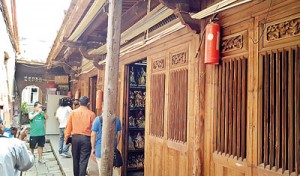Sunday Times 2
Sri Lanka a pearl in China’s past, present and future
View(s):Fascinating stories about a Lankan prince, Maritime Silk Road and the science of tea
By Ameen Izzadeen
What have a 19th generation Chinese descendant of a Sri Lankan prince, an 11th century mariner and three key cities in China got to do with 17 Sri Lankan journalists, who have just returned from a ten-day trip to China, courtesy the Chinese embassy in Colombo?

Plain tea and painting: Tea ceremony at the Anxi tea distribution centre
The answer: A fine silk thread connecting the ancient Maritime Silk Road with the new Maritime Silk Road that symbolises China’s rising soft power.
As we visited the three cities in our itinerary – first, the capital Beijing in the North-East, then the port city of Quanzhou (pronounced Chanzhou) in the South-East and Kumming the city of eternal spring in the West – the imaginary silk thread attached to us kept extending, just as the real silk thread extended from the boiled cocoon as the spool turned. The imaginary thread spun a tapestry depicting the places we visited, China’s glorious past and its dream for the future, with Sri Lanka shining like a pearl on the Maritime Silk Road – a key component of China’s ambitious One-Road-One-Belt (OBOR) project.
What do you think of the new Maritime Silk Road? This question was posed to me by a young Chinese journalist, who was among an army of media personnel covering our visit to the graveyard where a son of Parakramabahu VI and his descendants are believed to have been buried. Parakramabahu VI ruled Sri Lanka from the Kotte Kingdom from around the second decade in the 15th century to 1459,
“Well, it is a good idea, because enhanced trade ties can not only lead to an economic boom but also diminish the chances of countries going to war. We can achieve world peace. We must promote it,” I said, standing close to a place where Chinese archaeologists found tombstones describing the burial of the descendants of a Sri Lankan prince. He was known in China as Prince Ba Lai Na.

Intangible world heritage: The house where the Lankan prince lived (left) and the place where he is believed to have been buried. Chinese officials seek UNESCO recognition for the two places which are linked to the ancient Maritime Silk Road
Love in Quanzhou
The graveyard lies a short drive from our hotel in Quanzhou, which was the starting point of the ancient maritime silk Road. It is said that Zheng He, the renowned Chinese mariner, began at least six of his voyages from this port. Zheng He, a Chinese Muslim eunuch who served Emperor Yongle of the Ming dynasty, was no stranger to Sri Lanka. On his maiden voyage and subsequent voyages, he visited Sri Lanka.
It was he who is believed to have taken the Sri Lankan prince to China to meet the emperor. The prince on his journey back fell ill after he reached Quanzhou. It was winter, too. After his recovery, which took a long time, he had decided to remain in Quanzhou, where he fell in love with a noblewoman of Chinese-Arab origin with the surname Pu. After the Sri Lankan prince’s marriage to this woman, the emperor naturalised him and gave him the name Shi.
When we visited the ancient cemetery, Quanzhou’s cultural affairs officials told us that the totem on the tombstones showed two snakes in an art form that was popular in the 15th century Sri Lanka. More research was being carried out in both China and Sri Lanka, they said, adding that more evidence would expedite the process of declaring the story of the Sri Lankan prince and the artefacts associated with him as UNESCO world intangible cultural heritage. The Quanzhou port already enjoys this status following UNESCO’s recognition of the ancient Maritime Silk Road in 1991. “Intangible Cultural Heritage” is defined by UNESCO as practices, customs, knowledge and skills – as well as instruments, objects, artefacts and cultural spaces associated with them – that communities, groups and, in some cases, individuals recognise as part of their cultural heritage.
Our hosts, Quanzhou’s Foreign Affairs Committee officials, were keen to take us to as many such places of cultural importance as possible so as to underscore the links between Quanzhou, Sri Lanka and the ancient Maritime Silk Road.
The princess
First to a living heritage, a princess: We fondly called her Kumarikawa, meaning princess in Sinhala. Wearing a blue dress that gave her the appearance of a princess, 53-year-old Xushi Yine welcomed us to her handicraft and antique shop in Quanzhou. She said that to see us in her shop, where pictures she had taken of herself with Sri Lankan dignitaries such as Prime Ministers Ranil Wickremesinghe and D.M. Jayaratne and Speaker Karu Jayasuriya adorned the walls, gave her the feeling that she was being visited by her long lost relatives.
Xushi was a 19th generation descendant of the Lankan prince, as to whose real identity opinions differ among Sri Lankan historians. She took us to a house which was a stone’s throw away from her shop. “This was where the Sri Lankan prince lived 600 years ago,” she told us. “The house has, over the years, undergone renovations, while its ownership has changed from the Shi family.” Although owned by its present occupiers, the house is under the care of the Quanzhou municipal government, because it is part of the ancient Maritime Silk Road heritage.
Xushi was zeroed in as a present day descendant of the Sri Lankan prince, following the Sri Lankan government’s request to the Chinese government in 1986 to trace the lost tribe of the Lankan prince. A decade-long search led them to a cemetery where they found the tombstones with inscriptions to say that the remains were of the descendants of a Sri Lankan prince. It was later found that even in Taiwan there are descendants of the prince.

Kumarikawa: Xushi Yine, the 19th generation Chinese descendant of a Sri Lankan prince
At Quanzhou’s maritime museum, which showcases the historic Maritime Silk Road, curator Ding Yuling told us that a book is being written about the Lankan prince. Other officials said a docudrama is being made about Xushi, who has emerged as Quanzhou’s icon representing Chinese President Xi Jinping’s ambitious Maritime Silk Road Project which seeks to link Colombo, Hambantota and other key ports in the Afro-Asian region with Quanzhou, the largest metropolitan region in China’s Fujian Province.
Quanzhou’s history records visits by traders, seafarers and explorers. Among them were the Persians, the Arabs, the most notable among them being Ibn Batuta, the Europeans, among them was Marco Polo, the Tamils from Tamil Nadu and, of course, the Sri Lankan Sinhala prince. Buddhist pagodas, Hindu kovils, Christian churches, Muslim mosques and Manichaean temples stood side by side as the city emerged as a classic example of the Chinese people’s respect for multiculturalism. Basking in its glorious past, Quanzhou with a population of 8 million people in an area of 11,250 square kilometres, is emerging as one of the world’s largest ports. Its people believe President Xi Jinping’s ambitious OBOR initiative will once again make this port city a pivot of world trade.
Live and let live
The message from Quanzhou’s history is that in trade relations between people of different countries, cultures, religions and races, co-existence is a blessed byproduct. This is also the message that Quanzhou wants to give the rest of the world as it gears up for the Maritime Silk Road project, which is, according to Chinese officials, a live-and-let-live initiative that will propel the economy of not only China’s south but also other countries all the way up to Somalia and Djibouti, where China is building a naval base – not far from an American military base — to ensure maritime security in the Indian Ocean.
In 2014, Sri Lanka and China entered into a defence and maritime security cooperation agreement. This and another agreement that gave China the right to explore Sri Lanka’s ocean for the wreckage of ships of Zhang He’s fleet apparently raised alarms in New Delhi and Washington. Asked about this agreement to explore Sri Lankan waters, Quanzhou Museum Curator Ding said she was aware of this agreement, but her museum or marine archaeologists of Quanzhou were not involved in it, though they have the technology to do so. She also said the museum maintained academic ties with Sri Lanka’s universities and she was keen to visit Sri Lanka’s maritime museum in Galle. A delegation of Quanzhou maritime museum officials is expected to visit Sri Lanka in November.
Quanzhou’s officials dismissed the idea that China entertained any military ambitions through its Maritime Silk Road project. They insisted it was purely aimed at improving trade, academic and friendly relations. They said that many companies based in their “prospering city” had expressed a willingness to invest in Sri Lanka.
Tea science and tea art
Our three-day stay in Quanzhou also took us to Anxi, one of its counties, and the birthplace of tea. It is said people in this area used tea as a herb more than 3000 years ago and as a hot reviving brew some 2,500 years ago. Today, tea is also a cold sweet drink in China. Sri Lanka may be the world’s number one tea exporting country, but the first tea saplings were brought to Sri Lanka by British planters from China in 1824. Given this history, I felt that our visit to Anxi was like a reunion between a mother and a child long separated from her.
It is in Anxi County that we learnt the word ‘teaology’ – the science of tea. At the Anxi Tea College of the Fujian Agriculture and Forestry University, students are offered degrees to doctorates in teaology.
Television cameras followed us when we visited Anxi, the region that produces China’s best tea and houses the nation’s largest tea distributing centre. Chinese journalists asked whether I liked Chinese tea. Of course, I said. “It is a health drink, like Sri Lanka’s black tea.” I told them the two countries should cooperate and learn from each other’s knowledge and experience in tea production.
But a problem is the language barrier. At the Anxi Tea College officials said the courses were in Chinese but they had plans to introduce courses in English and open the college to foreign students. Tea is not only a science; it is an art linked to tradition. At the Anxi tea distribution centre, two Chinese girls, clad in green kurtas and white pants, performed the tea ceremony for us. While one girl painted a flower on a white paper, the other girl’s slender hands moved like waves as she handled the utensils to make hot tea for us. With Anxi offering many useful tips to Sri Lanka’s tea trade, we realised that the visit was worth all the tea in China.
(More next week.)

